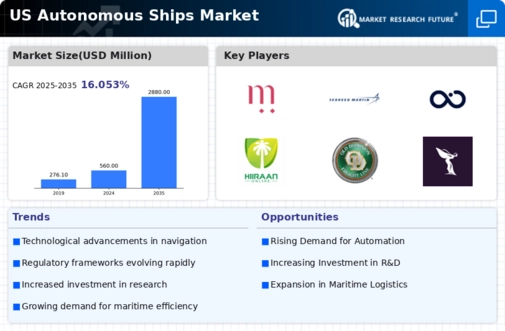Shift in Consumer Preferences
The autonomous ships market is witnessing a significant shift in consumer preferences towards automation and digitalization. As end-users become more accustomed to technology-driven solutions in various sectors, their expectations for shipping and logistics are evolving. Consumers are increasingly favoring services that offer transparency, speed, and reliability, which autonomous vessels can provide. This shift is prompting shipping companies to invest in autonomous technologies to meet changing consumer demands. Market analysts suggest that the adoption of autonomous ships could enhance customer satisfaction by providing real-time tracking and improved delivery times. As consumer preferences continue to evolve, the autonomous ships market is likely to see increased adoption and integration of these technologies.
Increased Demand for Efficiency
The autonomous ships market is experiencing a surge in demand for operational efficiency. Companies are increasingly seeking ways to reduce operational costs and enhance productivity. Autonomous vessels can operate with minimal human intervention, which potentially leads to lower labor costs and reduced human error. According to recent estimates, the operational cost savings from implementing autonomous technology could reach up to 30% over traditional shipping methods. This drive for efficiency is particularly pronounced in the logistics and shipping sectors, where margins are often tight. As businesses strive to optimize their supply chains, the autonomous ships market is likely to benefit from this trend, as stakeholders recognize the potential for improved turnaround times and enhanced service delivery.
Growing Environmental Regulations
The autonomous ships market is increasingly influenced by stringent environmental regulations aimed at reducing emissions and promoting sustainable practices. Regulatory bodies are implementing measures that require vessels to comply with lower emissions standards, which is driving the adoption of cleaner technologies. Autonomous ships, often equipped with energy-efficient systems, can help operators meet these regulations more effectively. The market is witnessing a shift towards greener shipping solutions, with projections indicating that compliance with environmental standards is expected to lead to a 20% reduction in operational emissions. This regulatory landscape is likely to propel the growth of the autonomous ships market as companies seek to align with sustainability goals.
Investment in Research and Development
Investment in research and development (R&D) is a crucial driver for the autonomous ships market. As companies and governments recognize the potential of autonomous technology, funding for R&D initiatives is increasing. This investment is aimed at enhancing the safety, reliability, and efficiency of autonomous vessels. In the US, federal and state governments are allocating resources to support innovation in maritime technology, which could lead to breakthroughs in navigation systems and vessel design. The autonomous ships market is expected to benefit from these advancements, as enhanced R&D efforts may result in more sophisticated and capable vessels, ultimately attracting more stakeholders to the industry.
Technological Integration and Innovation
The integration of advanced technologies is a key driver in the autonomous ships market. Innovations such as artificial intelligence, machine learning, and advanced sensor systems are transforming maritime operations. These technologies enable vessels to navigate autonomously, monitor environmental conditions, and make real-time decisions. The market for autonomous ships is projected to grow significantly, with estimates suggesting a compound annual growth rate (CAGR) of over 15% from 2025 to 2035. This technological evolution not only enhances safety and efficiency but also opens new avenues for data analytics and predictive maintenance, further solidifying the role of technology in shaping the future of maritime transport.























Leave a Comment